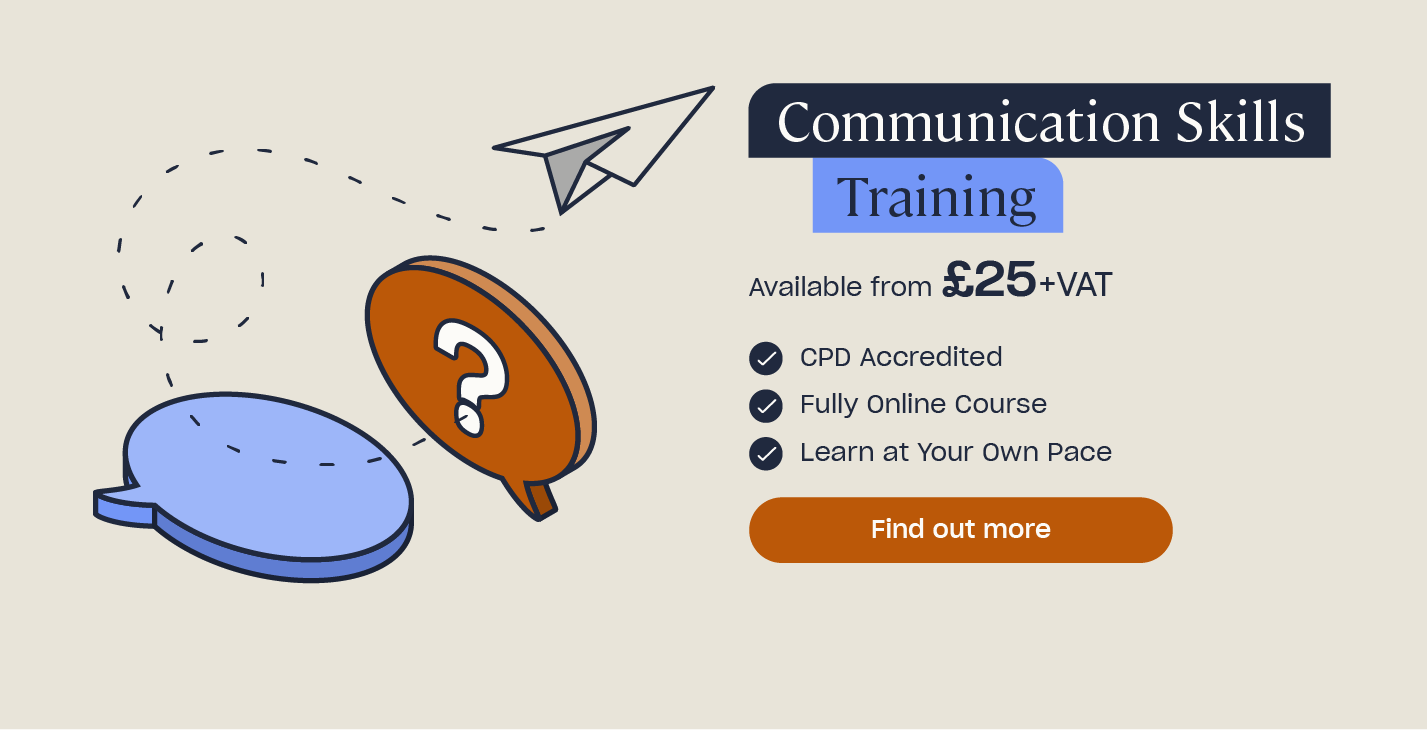How to Promote Inclusive Communication in the Workplace
Communication skills are among the top transferable skills in the workplace and play an important part in all areas of our lives. We communicate in so many ways that we are often not even aware of using these skills. Communication is about connecting with people, and as such we must ensure that our communication is as inclusive as possible in order to promote equality and diversity. In this article, we will define what is meant by inclusive communication, explore why it is important and discuss a range of strategies that you can use in order to promote inclusive communication. Every colleague should be aware of striving to make communication in the workplace as inclusive as possible.
What is Inclusive Communication?
Before we can define inclusive communication, it is worth exploring what communication is. Communication covers the many ways that we exchange information with others – the word itself comes from the Latin term ‘communicare’, meaning to share.

Verbal and Non-Verbal Communication
Verbal communication is any communication that involves words. This can be spoken (such as telephone calls, presentations or conversations) or written (such as reports, adverts, emails, letters and texts).
Non-verbal communication is any communication that is not word-based.
It includes:
- Visuals such as photography, illustrations and emojis.
- Body language, facial expression and gesture.
- The ‘way’ in which we say things – volume, pitch, tone and inflection.
Communication can be synchronous (happens in real time, such as a telephone or video call, an in-person presentation or a face-to-face conversation or group meeting) or asynchronous (that which does not happen in real time, such as a letter, an email, a report or a pre-recorded video, pitch or presentation).
There are advantages and disadvantages to all different types of communication and your choice of methods will be influenced by what information you are looking to share, who you are sharing with, and what the objectives of the communication are.
If you think about your average working day, you will probably notice that you encounter, and participate in, a mixture of verbal and non-verbal, asynchronous and synchronous communication.

Inclusive Communication
Inclusive communication does not exclude or discriminate against anyone, either intentionally or unintentionally. Often, we might not be aware of any potential negative implications, or barriers, that our communication may present.
By taking pains to make your communication as inclusive as possible, you will help to ensure that the information that you are sharing is accessible for all.
This applies to all modes of communication – from emails to conversations – and to both the content and the method of that communication.
Central to promoting inclusive communication is acknowledging that people have different communication preferences and needs – all of which should be respected.
Finding ways to embrace everyone’s communication styles can make everyone feel like they’re being heard.
Charlotte Leeming, broadcaster and journalist
Why is Inclusive Communication Important in the Workplace?
An inclusive approach to communication in the workplace takes steps towards ensuring that every member of staff, customer or client feels equally valued and respected. Effective communication is central to the success of most teams and businesses. As a leader or manager, you need to make sure that all your colleagues are empowered to communicate effectively.

In addition, there is a legal requirement for workplaces to avoid discrimination and promote inclusion. The Equality Act 2010 makes it unlawful to discriminate against people on the basis of nine protected characteristics.
These are:
- Age.
- Disability.
- Gender reassignment.
- Marriage or civil partnership.
- Pregnancy and maternity.
- Race.
- Religion or belief.
- Sex.
- Sexual orientation.
You must ensure that your communication is in line with your obligations under this Act. See our article, How Equality and Diversity Improves Your Workplace, for general information regarding promoting equality and diversity.
Written, spoken and visual communication carries a great power and can directly impact whether or not your employees feel valued. By promoting inclusive communication, everyone benefits, not just those who might otherwise feel excluded.
Further your knowledge
Our Communication Skills course, written in collaboration with journalist and broadcaster, Charlotte Leeming, takes an in-depth look at how to develop effective communication skills. Our library of business essentials courses can be found here, including Leadership and Management and Equality and Diversity.
How Do I Promote Inclusive Communication at Work?
Here we will look at some key principles followed by how you can promote inclusive communication in some common workplace contexts.
Awareness
The first step to promoting inclusion through communication is to be aware of where there might be barriers in the first place. You could start by considering unconscious bias. As the term suggests, these are values and opinions formed unconsciously through many different influences in our lives – background, media, etc. Try completing our Unconscious Bias Quiz as a start point.

Consider Your Audience
We all adapt our communication style and methods depending on who we are communicating with, and our relationship to them. Think of a simple greeting. The words, tone and any accompanying gesture you use will differ wildly when greeting your boss, a new client, your sibling or your best friend.
Whilst you should aim to embed a culture of inclusive communication in the workplace by applying some of the general principles we will cover, it is also important that you adapt to any specific needs of the people you are seeking to communicate with.
For example, if a member of your team has a hearing impairment, then the ways you adapt your communication within your team might be specific to them. You might, for example, provide written material, make sure you face them when speaking if they lip-read, and learn some key phrases in British Sign Language – if they sign. You should never make assumptions about adjustments that an individual may need – ask them and be led by them.
However, if you are preparing to communicate with a large group of customers through an advertising campaign, then you will want to try to consider as many different general needs as possible. This could include making the print dyslexia friendly, potentially including translated materials, making sure there are accompanying visuals to back up the messaging, ensuring diversity in photography or illustration, etc.

Inclusive Language
Why is inclusive language important? Striving to use inclusive language means avoiding any terms that could reinforce stereotypes, or unintentionally discriminate. This should apply to both written and spoken communication. Some ways you can do this include:
- Avoid gendered language – such as ‘the guys’, ‘chairman’ or ‘cleaning ladies’.
- When referring to gender, your language should not assume a binary view – so rather than using terms such as ‘both genders’ you should refer to ‘all genders’.
- Ask people what their preferred gender pronouns are – and respect them. Alongside binary gender pronouns, such as he or she, many people prefer non-binary pronouns such as they or ze. Some workplaces include this information on email signatures, so that new contacts are instantly aware of those preferences.
- Avoid language which discriminates in terms of age – such as ‘fresh out of college’.
- When referring to disability, do not use phrases with negative implications such as ‘suffers from’ or ‘afflicted by’.
- In most cases, use person-first language – ‘person with disability’ rather than ‘disabled person.’ However, within the autistic community, identity-first language – autistic person rather than person with autism – is generally preferred.

If you are in doubt as to how a person would like to be described, ask them. This shows consideration and will avoid unintentionally alienating or offending someone.
Neurodiversity and Communication
It is estimated that around 1 in 7 people are neurodivergent. This means that their brains process and interpret information differently to the majority of the population. This includes autistic individuals, in addition to people with specific learning difficulties (attention hyperactivity deficit disorder (ADHD), dyslexia, dyspraxia, dyscalculia and dysgraphia) and Tourette’s syndrome.
Neurodivergence should be viewed as a difference to be supported rather than as an impairment. Part of that support should come through inclusive communications.
No two individuals are the same – this is true for both neurotypical and neurodivergent people. Each autistic person, for example, will have different communication differences and experience different strengths and challenges. This means that any adjustments to communication should be based on that individual’s particular needs.
However, as an organisation, you can create a workplace culture which supports neurodivergence and ensures everyone is aware of how to make their communications more inclusive for neurodivergent colleagues. Our Autism Awareness course would be useful for anyone wanting to know more about how to support autistic individuals in the workplace.
Some general tips include:
- Be clear and concise in what you communicate – break instructions into chunks.
- Don’t expect ‘small talk’ – many (but not all!) neurodivergent people find this difficult and confusing.
- Be specific – for example, don’t say ‘later’ or ‘soon’. Give a definite time or date.
- Avoid metaphor, sarcasm or idiom – such as ‘let’s smash this’ or ‘you’re a star’. Some neurodivergent individuals interpret language very literally.
- Adjust your expectations regarding the meaning behind some non-verbal communication – don’t be offended if a handshake is not offered, or eye contact is inconsistent.
- Adjust your expectations regarding listening – some people may need to interject, interrupt, fidget or move.
- Do not ask ‘open’ questions – for some neurodivergent people, these bring too much uncertainty and they respond better to questions with concrete answers.
- Use visuals to reinforce spoken communication.
- Make your written communication dyslexia-friendly (consider fonts and backgrounds, etc.).
Everyday Inclusive Workplace Communication
The following tips can help you to promote inclusive communication as part of some everyday business activities.
Recruitment
Considerations could include:
- Making documentation available in a variety of accessible formats – including in languages other than English and Braille.
- Making sure written information is clear, concise, accurate and, where possible, supported by visuals.
- Offering alternatives to traditional interviews. Video interviews, pre-recorded presentations or trial days can sometimes support those who have communication differences around social interaction.
- Ask candidates if they require any specific adjustments – such as a BSL interpreter at interview.

Meetings
Considerations could include:
- Allowing staff to choose how they attend – in person or remotely.
- If questions are invited, allowing these to be submitted in a variety of ways (verbally, written, etc).
- Making sure the venue is accessible – consider any visual, auditory and other sensory implications.
Presentations
Considerations could include:
- Providing a BSL interpreter.
- Recording the presentation so people can access it at a later point, and repeatedly if they wish too.
- Allowing team members to attend remotely.
- Making sure printed material is available alongside an on-screen presentation. Providing translated material if needed.
- Being mindful of any social interaction expectations which might be challenging for some colleagues.
Inclusive Leadership
As a manager or leader, you have responsibility for promoting inclusive communication styles, for making workplace expectations clear and for creating a welcoming and open culture in your organisation.
It is important that you engage with your team and get regular feedback relating to inclusion. This helps to make you aware of any concerns they may have, and enables you to take steps to address them.
Inclusive Communication Skills & Strategies
Inclusive communication in your workplace could encompass a wide range of specific examples. By applying some of the general principles already covered, and working to develop and apply the following skills, you should feel confident to promote inclusive communication in a wide range of workplace contexts.

Develop Empathy
Developing empathy for others will help you to establish more effective relationships. By trying to see things from others’ perspectives, you are more likely to recognise when communication might not be inclusive, and therefore be able to respond. When we understand somebody better, we can communicate with them more effectively. This results in greater clarity, enriched relationships, increased productivity and improved wellbeing for all.
Practise Active Listening
Active listening can help you to develop empathy and is a key communication skill. It involves really concentrating on what the other person is trying to communicate – without focussing on what you want to say next, or bringing any judgement or preconceived ideas. Our Hub article, How to Improve Active Listening in Communication has further details on how to build this skill.
Adopt a Growth Mindset
By recognising that there is always something to learn about being more inclusive in our communications, you can grow through mistakes and strive to improve. This is essential as language and communication does not stand still but develops. Adopting a growth mindset will allow you to do the same.
In conclusion, inclusive communication is essential for creating an inclusive workplace, where everyone feels valued and can bring a diverse range of skills and qualities to your organisation. By recognising that individuals may have different communication styles and needs, alongside embedding general principles such as inclusive language, active listening and empathy, you can make sure that inclusive communication is promoted in your workplace.
Further Resources:
- How to Improve Active Listening in Communication
- Transferable Skills: What Are They and Why Are They Important?
- Communication Skills Training
- The Importance of Team Building Activities in the Workplace
- How Does Dyspraxia Affect Adults?
- How to Help Others Promote Diversity, Equality and Inclusion
- Equality, Diversity and Inclusion Policies in the Workplace: Free Template
- What is the Importance of Effective Communication in the Hospitality Industry?
- How to Promote Equality, Diversity and Inclusion in the Workplace
- Importance of Respect in the Workplace
- How to Avoid Dyslexia Discrimination in the Workplace











